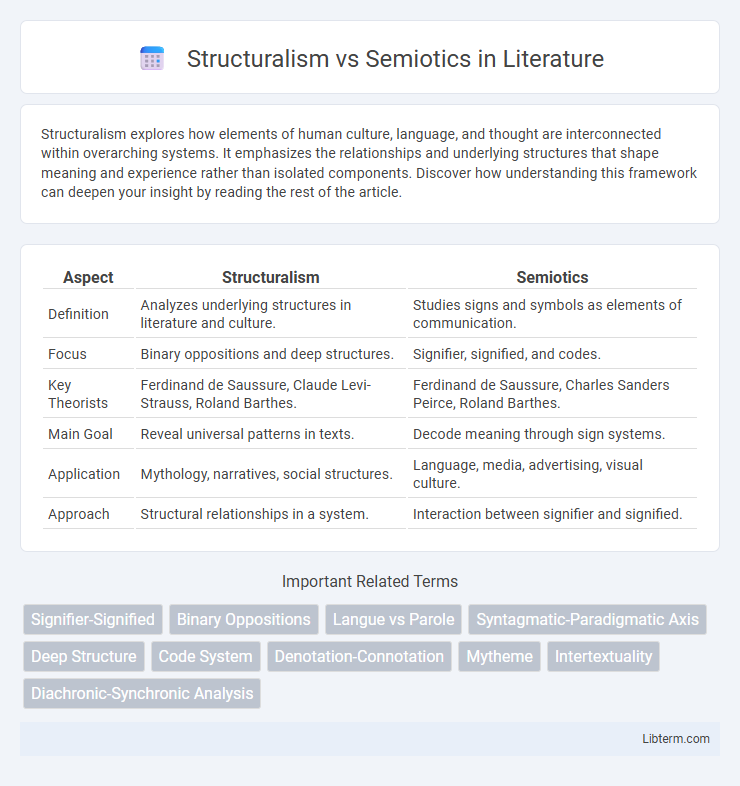Structuralism explores how elements of human culture, language, and thought are interconnected within overarching systems. It emphasizes the relationships and underlying structures that shape meaning and experience rather than isolated components. Discover how understanding this framework can deepen your insight by reading the rest of the article.
Table of Comparison
| Aspect | Structuralism | Semiotics |
|---|---|---|
| Definition | Analyzes underlying structures in literature and culture. | Studies signs and symbols as elements of communication. |
| Focus | Binary oppositions and deep structures. | Signifier, signified, and codes. |
| Key Theorists | Ferdinand de Saussure, Claude Levi-Strauss, Roland Barthes. | Ferdinand de Saussure, Charles Sanders Peirce, Roland Barthes. |
| Main Goal | Reveal universal patterns in texts. | Decode meaning through sign systems. |
| Application | Mythology, narratives, social structures. | Language, media, advertising, visual culture. |
| Approach | Structural relationships in a system. | Interaction between signifier and signified. |
Introduction to Structuralism and Semiotics
Structuralism analyzes cultural phenomena by examining underlying structures, such as language, myths, and social practices, emphasizing the relationships between elements within a system. Semiotics, the study of signs and symbols as a significant part of communication, explores how meaning is created and interpreted through codes and signifiers. Both fields intersect by investigating how meaning arises from underlying structures and patterns in language and culture.
Historical Background of Structuralism
Structuralism emerged in the early 20th century, primarily influenced by Swiss linguist Ferdinand de Saussure's work on language as a system of signs, laying the foundation for analyzing cultural phenomena through underlying structures. This theoretical approach gained prominence in the 1950s and 1960s, especially in France, with key figures like Claude Levi-Strauss applying it to anthropology and Roland Barthes to literary criticism, emphasizing how meaning arises from relationships within a system. Structuralism's historical development set the stage for semiotics, which expanded the study of signs beyond language to various forms of communication and cultural codes.
Origins and Development of Semiotics
Semiotics originated in the early 20th century with Charles Sanders Peirce and Ferdinand de Saussure as foundational figures, emphasizing the study of signs and symbols in communication. Unlike structuralism, which analyzes underlying structures in language, culture, and society through binary oppositions and systems, semiotics explores the process of signification and the relationship between the signifier, the signified, and the interpretant. The development of semiotics expanded through contributions from Roland Barthes and Umberto Eco, who applied these theories to media, literature, and cultural phenomena, establishing semiotics as a multidisciplinary field.
Key Theorists in Structuralism
Structuralism centers on analyzing cultural phenomena through underlying structures, with key theorists including Ferdinand de Saussure, who introduced the linguistic concept of langue and parole, and Claude Levi-Strauss, renowned for applying structuralist methods to myths and kinship. Roland Barthes bridged Structuralism and Semiotics by examining how signs create meaning within cultural texts. These theorists laid the foundation for understanding language, culture, and communication through systematic relationships and sign systems.
Foundational Figures in Semiotics
Ferdinand de Saussure is a foundational figure in semiotics, pioneering the structuralist approach to language by distinguishing between the 'signifier' and 'signified' within the linguistic sign. Charles Sanders Peirce further developed semiotics by introducing a triadic model comprising the representamen, object, and interpretant, emphasizing the interpretive process in meaning-making. These theorists laid the groundwork for semiotics as an interdisciplinary field analyzing signs and symbols beyond language, influencing cultural studies, communication, and media theory.
Core Principles of Structuralism
Structuralism centers on the idea that human culture and cognition are governed by underlying structures, often binary oppositions, that shape meaning and experience. It emphasizes the systematic relationships between elements within a system, such as language, myths, or social practices, revealing how meaning is constructed through these interrelated parts. The core principle asserts that individual components derive significance only in relation to the entire structure, making the whole greater than the sum of its parts.
Essential Concepts of Semiotics
Semiotics centers on the study of signs and symbols as fundamental units of meaning, emphasizing the relationship between the signifier (form) and the signified (concept). Structuralism provides the theoretical framework for semiotics by analyzing how these signs function within larger systems or structures, such as language, culture, or media. Key semiotic concepts include the signifier-signified duality, codes, and the interpretation process, which together reveal how meaning is constructed and communicated across contexts.
Comparing Structuralism and Semiotics
Structuralism analyzes cultural phenomena by examining underlying structures such as language, myths, and social systems, emphasizing binary oppositions and the deep rules governing meaning. Semiotics studies signs and symbols as a fundamental part of communication, focusing on the relationship between the signifier, the signified, and the interpretant in meaning-making processes. While structuralism seeks to uncover the universal frameworks shaping texts and societies, semiotics delves into the mechanisms of sign interpretation and the dynamic nature of meaning in various contexts.
Applications in Literary and Cultural Studies
Structuralism analyzes underlying structures in texts, such as language, myths, and narratives, to reveal universal patterns and cultural codes within literary and cultural studies. Semiotics extends this by interpreting signs and symbols, emphasizing the relationship between the signifier and signified to uncover deeper meanings and cultural ideologies. Both approaches are applied to decode media, literature, and popular culture, facilitating critical understanding of how meaning is constructed and communicated.
Future Trends in Structuralist and Semiotic Analysis
Future trends in Structuralist and Semiotic analysis emphasize the integration of digital technologies and artificial intelligence to decode complex cultural texts and media. Enhanced computational models enable deeper exploration of underlying structures and sign systems, facilitating more nuanced interpretations across diverse fields such as marketing, literature, and social sciences. The convergence of big data analytics with semiotic frameworks promises significant advancements in understanding evolving cultural narratives and consumer behavior patterns.
Structuralism Infographic

 libterm.com
libterm.com